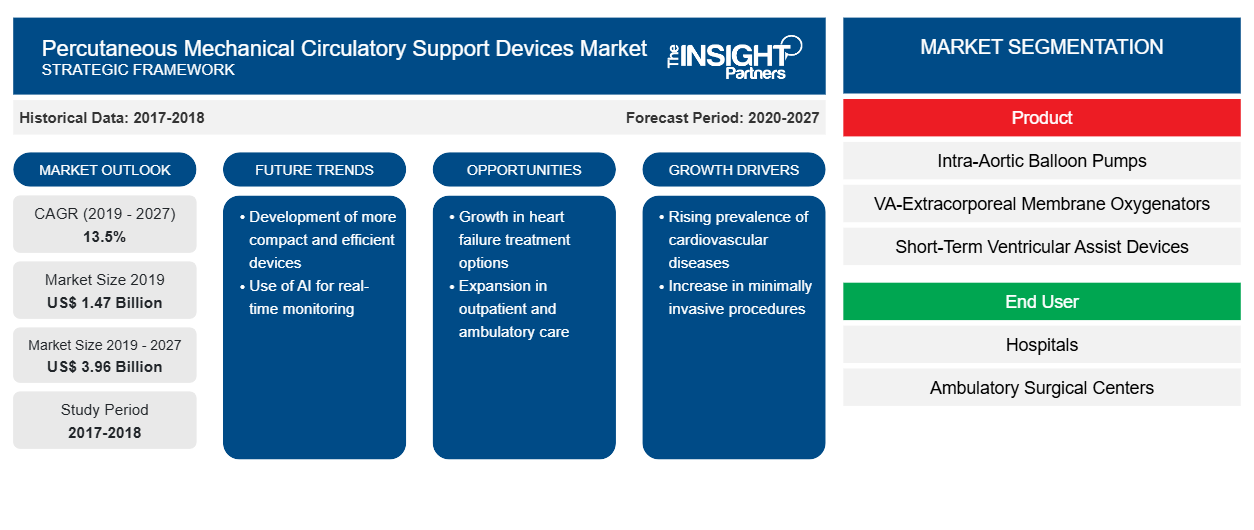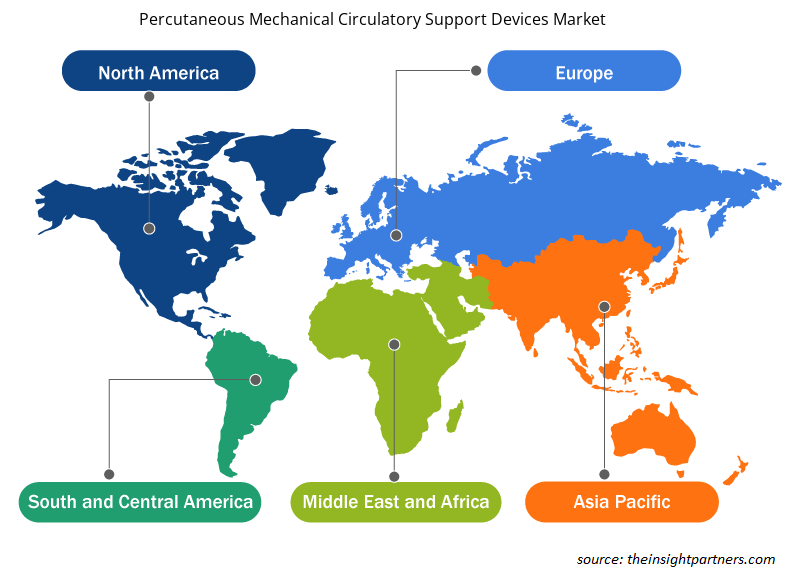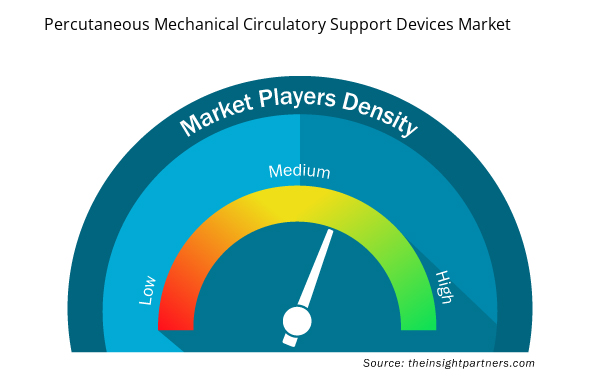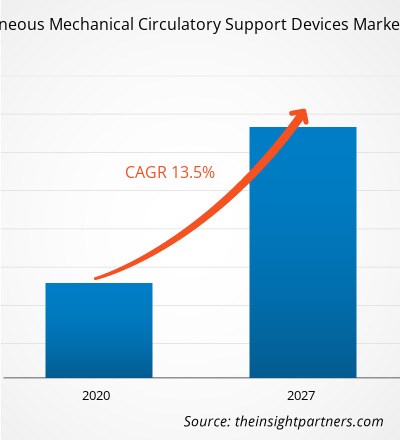بلغت قيمة سوق أجهزة دعم الدورة الدموية الميكانيكية عن طريق الجلد 1,474.28 مليون دولار أمريكي في عام 2019 ومن المتوقع أن تصل إلى 3,964.75 مليون دولار أمريكي بحلول عام 2027؛ ومن المتوقع أن ينمو بمعدل نمو سنوي مركب قدره 13.5٪ خلال الفترة 2020-2027.
تقدم أجهزة دعم الدورة الدموية الميكانيكية عن طريق الجلد طريقة فعالة وسريعة لإبطاء التدهور المستمر لعدم استقرار الدورة الدموية بين المرضى الذين يعانون من قصور القلب غير المعوض والصدمات القلبية حتى يتم التوصل إلى استراتيجية أكثر دقة بين المرضى للتعافي من هذه الأمراض القلبية. تشمل الأدوار الرئيسية لأجهزة دعم الدورة الدموية الميكانيكية عن طريق الجلد تحسين الناتج القلبي الطبيعي وتقليل حجم البطين وضغوط التعبئة وزيادة تدفق الدم التاجي والحفاظ على تدفق الدم إلى الأعضاء الحيوية.
رؤى السوق:
ارتفاع عدد السكان المسنين
من المتوقع أن يشهد السوق نموًا كبيرًا بسبب ارتفاع عدد كبار السن على مستوى العالم. في كل من الذكور والإناث، يزداد خطر الإصابة بأمراض القلب والأوعية الدموية مع تقدم العمر. تصبح الأوعية الدموية المتقدمة في السن أقل مرونة، مما يؤدي إلى انخفاض تدفق الدم. وبالتالي، فإن خطر الإصابة بأمراض القلب مرتفع لدى كبار السن. أيضًا، وفقًا لإحصائيات أمراض القلب والسكتة الدماغية لعام 2018، يبلغ متوسط العمر عند أول نوبة قلبية 65.6 عامًا للذكور و72.0 عامًا للإناث. كما ذكر أن معدل الإصابة السنوي بالنوبة القلبية في الولايات المتحدة هو 720.000 نوبة جديدة و335.000 نوبة متكررة. علاوة على ذلك، وفقًا للمعاهد الوطنية للصحة (NIH)، من المتوقع أن يتضاعف عدد سكان أمريكا الذين تزيد أعمارهم عن 65 عامًا تقريبًا على مدى العقود الثلاثة القادمة، من 48 مليونًا إلى 88 مليونًا بحلول عام 2050. تفرض أمراض القلب والأوعية الدموية ( CVD ) لدى كبار السن الأمريكيين عبئًا كبيرًا من حيث الوفيات والمرض والإعاقة والتدهور الوظيفي وتكاليف الرعاية الصحية. تشير دراسة استعادية أجرتها جامعة بيتسبرغ في عام 2015 إلى أن انتشار أمراض القلب والأوعية الدموية ، بما في ذلك ارتفاع ضغط الدم وأمراض القلب التاجية وقصور القلب والسكتة الدماغية، يزيد من حوالي 40٪ لدى الرجال والنساء الذين تتراوح أعمارهم بين 40 و 59 عامًا و 70-75٪ لدى الأشخاص الذين تتراوح أعمارهم بين 60 و 79 عامًا و 79-86٪ بين أولئك الذين تتراوح أعمارهم بين 80 عامًا أو أكثر. وبالتالي، فإن النمو السكاني المسن الذي يؤدي إلى ارتفاع مخاطر قصور القلب والصدمات القلبية يزيد من تطبيقات أجهزة دعم الدورة الدموية الميكانيكية عن طريق الجلد ويؤدي في النهاية إلى نمو السوق.
قم بتخصيص هذا التقرير ليناسب متطلباتك
ستحصل على تخصيص لأي تقرير - مجانًا - بما في ذلك أجزاء من هذا التقرير، أو تحليل على مستوى الدولة، وحزمة بيانات Excel، بالإضافة إلى الاستفادة من العروض والخصومات الرائعة للشركات الناشئة والجامعات
سوق أجهزة دعم الدورة الدموية الميكانيكية عن طريق الجلد: Mechanical Circulatory Support Devices Market:

- احصل على أهم اتجاهات السوق الرئيسية لهذا التقرير.ستتضمن هذه العينة المجانية تحليلاً للبيانات، بدءًا من اتجاهات السوق وحتى التقديرات والتوقعات.
رؤى السوق القائمة على المنتج
تم تقسيم قطاع منتجات سوق أجهزة دعم الدورة الدموية الميكانيكية عن طريق الجلد إلى مضخات البالون داخل الأبهر، وأكسجة الغشاء خارج الجسم عن طريق الوريد، وأجهزة مساعدة البطين قصيرة المدى. احتل قطاع مضخات البالون داخل الأبهر الحصة الأكبر من سوق أجهزة دعم الدورة الدموية الميكانيكية عن طريق الجلد في عام 2019. ومن المتوقع أن ينمو قطاع أجهزة مساعدة البطين قصيرة المدى بمعدل نمو سنوي مركب يبلغ 14.0% خلال الفترة المتوقعة.
رؤى السوق المستندة إلى المستخدم النهائي
يتألف قطاع المستخدم النهائي لسوق أجهزة دعم الدورة الدموية الميكانيكية عن طريق الجلد من المستشفيات ومراكز الجراحة الخارجية وغيرها. وقد احتل قطاع المستشفيات الحصة الأكبر من سوق أجهزة دعم الدورة الدموية الميكانيكية عن طريق الجلد في عام 2019. ومن المتوقع أيضًا أن ينمو القطاع بمعدل نمو سنوي مركب قدره 14.2% خلال الفترة المتوقعة.
تتبنى الشركات عادةً استراتيجيات إطلاق المنتجات والموافقة عليها لتوسيع نطاق تواجدها ومحفظة منتجاتها في جميع أنحاء العالم وتلبية الطلب المتزايد.
بالإضافة إلى ذلك، يتبنى اللاعبون في السوق العاملون في سوق أجهزة دعم الدورة الدموية الميكانيكية عن طريق الجلد استراتيجية التوسع لتوسيع قاعدة العملاء في جميع أنحاء العالم، مما يسمح للاعبين بالحفاظ على اسم علامتهم التجارية عالميًا. على سبيل المثال، في يونيو 2016، أطلقت شركة Medetronic منتجًا - Beacon، وهي خدمة إدارة الرعاية لمرضى قصور القلب المعرضين لخطر كبير. تجمع هذه الخدمة بين البيانات من أجهزة مزيل الرجفان القابلة للزرع من Medtronic (ICD) أو أجهزة علاج إعادة مزامنة القلب (CRT) مع المراقبة بعد الحادة من MCMS.
رؤى إقليمية حول سوق أجهزة دعم الدورة الدموية الميكانيكية عن طريق الجلد
لقد قام المحللون في Insight Partners بشرح الاتجاهات والعوامل الإقليمية المؤثرة على سوق أجهزة دعم الدورة الدموية الميكانيكية عن طريق الجلد طوال فترة التوقعات بشكل شامل. يناقش هذا القسم أيضًا قطاعات سوق أجهزة دعم الدورة الدموية الميكانيكية عن طريق الجلد والجغرافيا في جميع أنحاء أمريكا الشمالية وأوروبا ومنطقة آسيا والمحيط الهادئ والشرق الأوسط وأفريقيا وأمريكا الجنوبية والوسطى.

- احصل على البيانات الإقليمية المحددة لسوق أجهزة دعم الدورة الدموية الميكانيكية عن طريق الجلد
نطاق تقرير سوق أجهزة دعم الدورة الدموية الميكانيكية عن طريق الجلد
| سمة التقرير | تفاصيل |
|---|---|
| حجم السوق في عام 2019 | 1.47 مليار دولار أمريكي |
| حجم السوق بحلول عام 2027 | 3.96 مليار دولار أمريكي |
| معدل النمو السنوي المركب العالمي (2019 - 2027) | 13.5% |
| البيانات التاريخية | 2017-2018 |
| فترة التنبؤ | 2020-2027 |
| القطاعات المغطاة | حسب المنتج
|
| المناطق والدول المغطاة | أمريكا الشمالية
|
| قادة السوق وملفات تعريف الشركات الرئيسية |
|
كثافة اللاعبين في السوق: فهم تأثيرها على ديناميكيات الأعمال
يشهد سوق أجهزة دعم الدورة الدموية الميكانيكية عن طريق الجلد نموًا سريعًا، مدفوعًا بالطلب المتزايد من المستخدم النهائي بسبب عوامل مثل تفضيلات المستهلكين المتطورة والتقدم التكنولوجي والوعي المتزايد بفوائد المنتج. ومع ارتفاع الطلب، تعمل الشركات على توسيع عروضها والابتكار لتلبية احتياجات المستهلكين والاستفادة من الاتجاهات الناشئة، مما يؤدي إلى زيادة نمو السوق.
تشير كثافة اللاعبين في السوق إلى توزيع الشركات أو المؤسسات العاملة في سوق أو صناعة معينة. وهي تشير إلى عدد المنافسين (اللاعبين في السوق) الموجودين في مساحة سوق معينة نسبة إلى حجمها أو قيمتها السوقية الإجمالية.
الشركات الرئيسية العاملة في سوق أجهزة دعم الدورة الدموية الميكانيكية عن طريق الجلد هي:
- أبوت.
- ميدترونيك
- جيتنج ايه بي
- شركة تليفليكس المحدودة
- شركة ليفانوفا المحدودة (شركة كاردياكاسيست).
إخلاء المسؤولية : الشركات المذكورة أعلاه ليست مرتبة بأي ترتيب معين.

- احصل على نظرة عامة على أهم اللاعبين الرئيسيين في سوق أجهزة دعم الدورة الدموية الميكانيكية عن طريق الجلد
السوق العالمية لأجهزة دعم الدورة الدموية الميكانيكية عن طريق الجلد – حسب المنتج
- مضخات البالون داخل الأبهر
- أكسجة الغشاء خارج الجسم (ECMO)
- أجهزة الأكسجين
- أجهزة مساعدة البطين قصيرة المدى (VADs)
- إمبيلا
- القلب المزدوج
السوق العالمية لأجهزة دعم الدورة الدموية الميكانيكية عن طريق الجلد – حسب المستخدم النهائي
- المستشفيات
- مراكز الجراحة الخارجية
- آحرون
أجهزة دعم الدورة الدموية الميكانيكية الجلدية العالمية - حسب الموقع الجغرافي
أمريكا الشمالية
- نحن
- كندا
- المكسيك
أوروبا
- فرنسا
- ألمانيا
- إيطاليا
- المملكة المتحدة
- إسبانيا
- بقية أوروبا
آسيا والمحيط الهادئ (APAC)
- الصين
- الهند
- كوريا الجنوبية
- اليابان
- أستراليا
- بقية منطقة آسيا والمحيط الهادئ
الشرق الأوسط وأفريقيا
- جنوب أفريقيا
- المملكة العربية السعودية
- الامارات العربية المتحدة
- باقي منطقة الشرق الأوسط وأفريقيا
أمريكا الجنوبية (SAM)
- البرازيل
- الأرجنتين
- بقية سام
نبذة عن الشركة
- أبوت.
- ميدترونيك
- جيتنج ايه بي
- شركة تليفليكس المحدودة
- LivanovaPlc (Cardiacassist, Inc.).
- أبيوميد
- يوروسيتس
- قلب برلين
- جارفيك هارت، المحدودة
- شركة كارديوبريدج المحدودة
- التحليل التاريخي (سنتان)، السنة الأساسية، التوقعات (7 سنوات) مع معدل النمو السنوي المركب
- تحليل PEST و SWOT
- حجم السوق والقيمة / الحجم - عالميًا وإقليميًا وقطريًا
- الصناعة والمنافسة
- مجموعة بيانات Excel


- Broth Market
- Electronic Signature Software Market
- Lyophilization Services for Biopharmaceuticals Market
- Equipment Rental Software Market
- Biopharmaceutical Tubing Market
- Drain Cleaning Equipment Market
- Radiopharmaceuticals Market
- Vision Care Market
- Ceramic Injection Molding Market
- Sexual Wellness Market

Report Coverage
Revenue forecast, Company Analysis, Industry landscape, Growth factors, and Trends

Segment Covered
This text is related
to segments covered.

Regional Scope
North America, Europe, Asia Pacific, Middle East & Africa, South & Central America

Country Scope
This text is related
to country scope.
الأسئلة الشائعة
The North American region holds the largest market for the breast cancer screening. The United States held the largest market for percutaneous mechanical circulatory support devices market and is expected to grow due to factors such as increasing number ofincreasing prevalence of cardiovascular diseases & heart failures, growing developments for screening and imaging process by the companies and others.
The growth of the market is attributed to some key driving factors such as rising geriatric population, increasing prevalence of cardiovascular diseases & heart failures however, impact of COVID-19 pandemic on medical device industry and high cost of products and procedures is expected to restraint the growth of the market during the forecast years.
The percutaneous mechanical circulatory support devices market is highly competitive in nature with considerable number of players, having a high level of consolidation overall revenue share. Most of the companies operating in the percutaneous mechanical circulatory support devices market are present globally and have wide distribution and sales network through partnerships or authorized dealers.
Trends and growth analysis reports related to Life Sciences : READ MORE..
The List of Companies - Percutaneous Mechanical Circulatory Support Devices Market
- Abbott.
- Medtronic
- Getinge AB
- Teleflex Incorporated
- Livanova Plc (Cardiacassist, Inc.).
- Abiomed
- Eurosets
- Berlin Heart
- Jarvik Heart, Inc.
- CardioBridge GmbH
The Insight Partners performs research in 4 major stages: Data Collection & Secondary Research, Primary Research, Data Analysis and Data Triangulation & Final Review.
- Data Collection and Secondary Research:
As a market research and consulting firm operating from a decade, we have published and advised several client across the globe. First step for any study will start with an assessment of currently available data and insights from existing reports. Further, historical and current market information is collected from Investor Presentations, Annual Reports, SEC Filings, etc., and other information related to company’s performance and market positioning are gathered from Paid Databases (Factiva, Hoovers, and Reuters) and various other publications available in public domain.
Several associations trade associates, technical forums, institutes, societies and organization are accessed to gain technical as well as market related insights through their publications such as research papers, blogs and press releases related to the studies are referred to get cues about the market. Further, white papers, journals, magazines, and other news articles published in last 3 years are scrutinized and analyzed to understand the current market trends.
- Primary Research:
The primarily interview analysis comprise of data obtained from industry participants interview and answers to survey questions gathered by in-house primary team.
For primary research, interviews are conducted with industry experts/CEOs/Marketing Managers/VPs/Subject Matter Experts from both demand and supply side to get a 360-degree view of the market. The primary team conducts several interviews based on the complexity of the markets to understand the various market trends and dynamics which makes research more credible and precise.
A typical research interview fulfils the following functions:
- Provides first-hand information on the market size, market trends, growth trends, competitive landscape, and outlook
- Validates and strengthens in-house secondary research findings
- Develops the analysis team’s expertise and market understanding
Primary research involves email interactions and telephone interviews for each market, category, segment, and sub-segment across geographies. The participants who typically take part in such a process include, but are not limited to:
- Industry participants: VPs, business development managers, market intelligence managers and national sales managers
- Outside experts: Valuation experts, research analysts and key opinion leaders specializing in the electronics and semiconductor industry.
Below is the breakup of our primary respondents by company, designation, and region:

Once we receive the confirmation from primary research sources or primary respondents, we finalize the base year market estimation and forecast the data as per the macroeconomic and microeconomic factors assessed during data collection.
- Data Analysis:
Once data is validated through both secondary as well as primary respondents, we finalize the market estimations by hypothesis formulation and factor analysis at regional and country level.
- Macro-Economic Factor Analysis:
We analyse macroeconomic indicators such the gross domestic product (GDP), increase in the demand for goods and services across industries, technological advancement, regional economic growth, governmental policies, the influence of COVID-19, PEST analysis, and other aspects. This analysis aids in setting benchmarks for various nations/regions and approximating market splits. Additionally, the general trend of the aforementioned components aid in determining the market's development possibilities.
- Country Level Data:
Various factors that are especially aligned to the country are taken into account to determine the market size for a certain area and country, including the presence of vendors, such as headquarters and offices, the country's GDP, demand patterns, and industry growth. To comprehend the market dynamics for the nation, a number of growth variables, inhibitors, application areas, and current market trends are researched. The aforementioned elements aid in determining the country's overall market's growth potential.
- Company Profile:
The “Table of Contents” is formulated by listing and analyzing more than 25 - 30 companies operating in the market ecosystem across geographies. However, we profile only 10 companies as a standard practice in our syndicate reports. These 10 companies comprise leading, emerging, and regional players. Nonetheless, our analysis is not restricted to the 10 listed companies, we also analyze other companies present in the market to develop a holistic view and understand the prevailing trends. The “Company Profiles” section in the report covers key facts, business description, products & services, financial information, SWOT analysis, and key developments. The financial information presented is extracted from the annual reports and official documents of the publicly listed companies. Upon collecting the information for the sections of respective companies, we verify them via various primary sources and then compile the data in respective company profiles. The company level information helps us in deriving the base number as well as in forecasting the market size.
- Developing Base Number:
Aggregation of sales statistics (2020-2022) and macro-economic factor, and other secondary and primary research insights are utilized to arrive at base number and related market shares for 2022. The data gaps are identified in this step and relevant market data is analyzed, collected from paid primary interviews or databases. On finalizing the base year market size, forecasts are developed on the basis of macro-economic, industry and market growth factors and company level analysis.
- Data Triangulation and Final Review:
The market findings and base year market size calculations are validated from supply as well as demand side. Demand side validations are based on macro-economic factor analysis and benchmarks for respective regions and countries. In case of supply side validations, revenues of major companies are estimated (in case not available) based on industry benchmark, approximate number of employees, product portfolio, and primary interviews revenues are gathered. Further revenue from target product/service segment is assessed to avoid overshooting of market statistics. In case of heavy deviations between supply and demand side values, all thes steps are repeated to achieve synchronization.
We follow an iterative model, wherein we share our research findings with Subject Matter Experts (SME’s) and Key Opinion Leaders (KOLs) until consensus view of the market is not formulated – this model negates any drastic deviation in the opinions of experts. Only validated and universally acceptable research findings are quoted in our reports.
We have important check points that we use to validate our research findings – which we call – data triangulation, where we validate the information, we generate from secondary sources with primary interviews and then we re-validate with our internal data bases and Subject matter experts. This comprehensive model enables us to deliver high quality, reliable data in shortest possible time.

 احصل على عينة مجانية لهذا التقرير
احصل على عينة مجانية لهذا التقرير